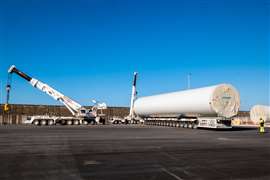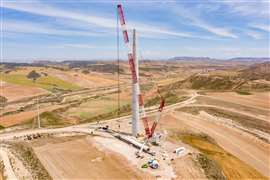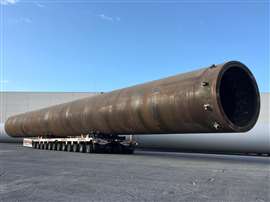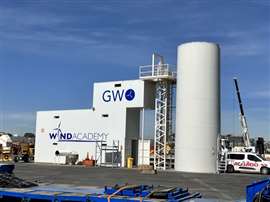Winds of change in Spain
30 May 2023
Recovering from the global financial crisis of 2008 has been a challenge for companies worldwide. In the wake of that financial crash Spanish family-run lifting and transport specialist Transportes y Grúas Aguado entered the wind energy market in a move that is really paying off.
 Transportes y Grúas Aguado has a separate division to handle the lifting and transport needs of the wind energy industry in Spain and further afield. Photo: Gruas Aguado
Transportes y Grúas Aguado has a separate division to handle the lifting and transport needs of the wind energy industry in Spain and further afield. Photo: Gruas Aguado
Recovering from the global financial crisis of 2008 has been a challenge for companies worldwide. In the wake of that financial crash Spanish family-run lifting and transport specialist Transportes y Grúas Aguado entered the wind energy market, a move that is paying off.
The wind industry in Spain does not get as much international publicity as the huge offshore developments in the North Sea and the Baltic. But it should.
Spain is one of the leading countries in the European Union in terms of installed wind energy capacity. The industry is an increasingly important sector of the country’s economy.
With falling costs, strong and consistent winds in many regions of the country and increasing demand for renewable energy, Spain has set a target of generating 74 per cent of its electricity from renewable sources by 2030. Wind energy will play a major role in meeting this goal.
This growing market has helped Madrid-headquartered Transportes y Grúas Aguado bounce back from the financial crash in 2008 to become an international player in the wind sector. Mario Aguado is managing director at Aguado’s Wind Services business and one of three brothers running the company set up by his parents. He explains the journey the company has been on.
“We are a family company with almost five hundred employees. The company was started by my parents in Madrid in 1982 and although the day-to-day work is today carried by myself, my two brothers and our great team, my parents are still working. My father, at the age of 66, is still regularly on the ground floor organising and talking to the staff, supervising all operations. But the real boss is my mum, with all the financial supervision of the company”
He continues, “We have grown pretty quickly. In the early 2000s, we were still mostly working in and around Madrid. But from then on, we started to develop all over Spain, at first with offices in Malaga and Algeciras, and later more widely across the whole country with the offices in Soria, Pamplona and Bilbao.”
In the run up to the crash, the Spanish market was hyper-active. “Until 2007, the market was amazing, but it was not stable – it did not make sense, it was not sustainable.
“This instability made managing the business very difficult. When the crash hit, we went from employing over 350 people to just 150. It was really, really painful, not just for us of course, but for all of society.”
Renewables for survival
In that period, the company decided – as part of its survival strategy – to move into renewable energy.
The renewable market was still new, but Aguado had the equipment for the civils works and in 2012 started to invest in specialized transport equipment – and to offer the trained manpower for the installation of turbines.
Mario Aguado continues, “This meant we could offer a full TCI service – transport, cranes and installation. We get all the components from the partner’s factory or port, perform all logistics and lifting activities, finishing with all internal works with the electro-mechanical teams. We see the project all the way through until the wind turbines are ready for commissioning.”
The decision was not without its difficulties, however. The renewables market in Spain was in its infancy and was uncertain, so in 2013 Aguado Wind Services – a wholly-owned company within the Aguado Group – started to look for work overseas.
Initial projects in Latin America proved difficult but demand closer to home, notably in Germany and Austria in 2014, was picking up fast, with the turbine manufacturers needing additional transport, lifting and installation capacity.
Today, Aguado can offer TCI services worldwide, using its own resources in Europe but, when required, partnering with local companies further afield. It is an approach that gives the company access to local market knowledge and contacts, and the necessary equipment capacity.
“Our partners have the local market knowledge, we have the expertise and together we can expand the local market capacity,” Aguado explains.
In Spain, one of the most important developments has been the growth of Aguado’s office in Bilbao. This opened in 2013 after it acquired the equipment of a local Basque transport company.
“We started with four employees outside the port and now we are inside the port with more than 80 people employed there. Our HQ remains in Madrid but there is a lot of industrial work and also a lot of wind industry export activity in Bilbao through the port – we do the logistics for the main OEMs in Bilbao Port,” Aguado continues.
“As for the state of the market, it looks like we will have a lot of work for the next two years, and then it should be steady up to 2030, but with what is happening in the world, you never know.”
The difficulty of managing a business in recent turbulent times is reflected in the company’s turnover – which fell by more than half by 2011 before rising steadily to well above its pre-crash peak at €60 million last year, with almost 65 % of that coming from the wind sector.
 The Aguado fleet includes crawler cranes up to 1,000 tonnes capacity and more new cranes are on the way. Photo: Gruas Aguado
The Aguado fleet includes crawler cranes up to 1,000 tonnes capacity and more new cranes are on the way. Photo: Gruas Aguado
Investing in expansion
The growth has helped drive the company’s continued strategic expansion and investment.
“Today we can proudly say that thanks to our team and vision, in only 10 years we have been doing projects in more than 20 countries worldwide.
“We are well established all over Europe – mainly in Germany, Denmark, Sweden and France – and also in Mexico, Colombia, Peru, Chile and South Africa”
He added that the Aguado Group decided to diversify as much as it could while staying focused on the wind industry. As an example, the company invested in Haizea Wind, a leading manufacturer of wind tower sections for onshore and offshore wind farms, along with the casting of hubs, frames and shafts, and also offshore fundations such as XXXL size monopiles.
Aguado is watching closely the potential market for replacing old wind turbines as the first generation units come to the end of their design life.
The company has continued to invest steadily in new equipment. Acquisitions in recent years include 10 crawler cranes up to the 1,000 tonne capacity Liebherr LR 11000, plus 25 all terrain cranes between 100 and 1,000 tonnes. It has also invested in a Liebherr LG 1750 SX3 lattice boom wheeled mobile crane, mainly for work in Germany.
Two 800 tonne capacity crawler cranes are due for delivery by the end of 2023.
On the transport side a Goldhofer FTV 850 blade lifter has been added to the fleet and Aguado owns 60 lines of self propelled modular transporter (SPMT).
 On the move: Aguado owns 60 lines of SPMT and continues to invest in its equipment fleet. Photo: Gruas Aguado
On the move: Aguado owns 60 lines of SPMT and continues to invest in its equipment fleet. Photo: Gruas Aguado
In total, the company runs a fleet of around 180 cranes along with conventional and special transport equipment plus a heavy load railway wagon. Mario Aguado is concerned that the cost of new equipment might be a problem in future.
“The prices of cranes and transport equipment are getting crazy and the problem is that some rental company cannot – or do not want to – reflect the cost in the rental rates. Others, who have older cranes that they have owned for a long time, charge lower rates.
“But this is a huge mistake because you always need to invest in new machinery and you have to take into account always the cost of the crane, even if it is an old machine. Otherwise you cannot be positive about the destiny of your company.”
Apart from rising costs, a second concern – one shared with a great many European companies – is skills shortages.
“Clearly we have a problem with shortages of skilled people. We are not alone in this. There are not enough drivers, there are not enough crane operators and there are not enough installation technicians.”
The company has its own training operation and its Wind Academy is a training provider certified by GWO, the Global Wind Organisation. Aguado explains, “This is really important. Through our academy we are not only carrying out wind installation training but we are also training crane operators, telehandler operators, and we want to be able offer certified SPMT training.
“We currently carry out SPMT training internally but we would like to be able to offer it to an accepted international standard.”
The training is available to external companies as well as Aguado employees.
Even if skills and costs are a concern, the prospects look good. A recent sign of market confidence in Spain’s wind energy sector was the announcement at the end of last year of the Basque Government-funded Megawind project, supported by some of Europe’s biggest wind energy and services companies, including Aguado.
The three-year project aims to adapt and improve monopiles to support bigger offshore wind turbines – that is, those that are 15 MW and above in capacity.
With the growth of Spain and Europe’s wind industry showing no sign of slowing – and with various international markets looking to get on the bandwagon – Aguado Group’s strategic shift into the wind market is looking good for some years to come.
GWO and training – boosting the skills pipeline
Aguado Wind Services’ Wind Academy is a certified training provider under the auspices of the Global Wind Organisation (GWO).
 Aguado Wind Services’ Wind Academy training centre building in Spain. Photo: Gruas Aguado
Aguado Wind Services’ Wind Academy training centre building in Spain. Photo: Gruas Aguado
GWO is a coalition formed by several of the most important companies worldwide in the wind energy sector. One of the main objectives has been the development of a training standard to train and qualify all professionals or future professionals related to the wind sector under common safety guidelines.
“All of our Aguado Wind Services technicians receive comprehensive training and we offer our clients this type of training so that they are certified by the GWO,” explains Mario Aguado.
Wind Europe, the Brussels-based trade association, has recognised GWO training as the minimum level required of any worker in the wind energy industry. Since it came into force in 2013, GWO training can only be provided by certified entities.
Mario Aguado said, “We were one of the first GWO training centres in Spain. We want to have our people trained and we like to have a pipeline of your people coming through who are trained.”
CONECTAR-SE COM A EQUIPE





